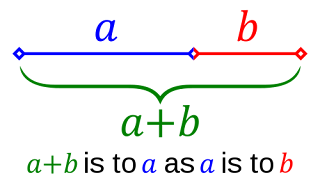Diagram of the Golden Ratio (from Wikipedia).
It should be noted that Margarita Martínez de Sobral previously suggested that the ancient Mesoamerican peoples employed the Golden Ratio in their art and architecture. She pointed to the proportions of Lintel 25 from Yaxchilan, but she offered few architectural examples of the principle. Martínez de Sobral also discussed several other interesting geometric constructions that may be observed in ancient Mesoamerican art and architecture.
I hope that Doyle's article inspires further research into this interesting aspect of ancient mathematics and aesthetics.
References
Doyle, James A. (2013). Early Maya geometric planning conventions at El Palmar, Guatemala. Journal of Archaeological Science 40:793-798. http://dx.doi.org/10.1016/j.jas.2012.08.006.
Martínez de Sobral, Margarita (2000) Geometría Mesoamericana. México: Fondo de Cultura Económica.


Just came across this post, thanks for the note! And for the Martínez de Sobral reference, I'll definitely check it out.
ReplyDeleteJames Doyle